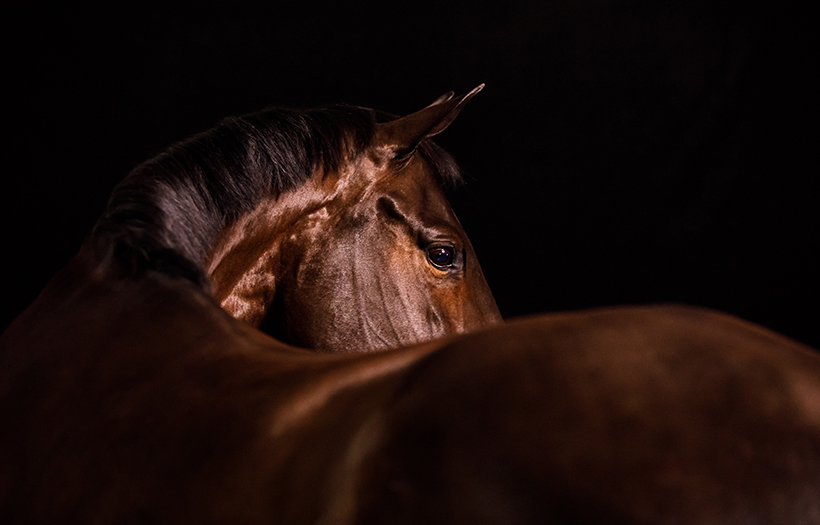IRON METABOLISM AND INSULIN RESISTANCE IN THE HORSE

Iron metabolism and insulin resistance in the horse
The amount of iron in the horse’s diet has become a topic of much discussion and concern for many horse owners. And there has been a great deal of confusion whether dietary iron levels can affect insulin resistance in the horse. Following is a brief discussion of iron metabolism and what we know about it regarding insulin resistance in the horse.
Iron is a necessary micronutrient for the horse and is a component of red blood cells, muscle cells and many enzyme systems. The estimated dietary requirement for a mature 1,100-pound horse is 400 mg per day1. Iron deficiency is extremely rare and has not been shown to be a problem in foals or mature horses if they have access to soil. Forages and other feedstuffs contain more than adequate amounts for horses. Iron absorption is estimated to be only about 15% of the total amount of iron due to saturation of absorption sites in the small intestine because of the large amount of iron available in the horse’s normal feedstuffs. Iron toxicity is also rare in the horse, with the greatest risk of toxicity and death occurring in foals given supplemental iron. The maximum tolerable concentration of iron in the horse’s diet has been set at 500 mg/kg2.
A research study was performed using horses as a model for investigating iron overload disorder in captive rhinoceroses (i.e., rhinos)2. This disorder affects captive rhinos but has not been documented in wild rhinos. Iron overload or toxicosis can cause oxidative stress, inflammation and organ damage in rhinos and other mammals. Compared with wild rhinos, captive rhinos eat diets containing more iron, have greater fat stores and exercise less. This problem may be linked to development of insulin resistance and an equine model was used to investigate the relationship between iron status and insulin resistance. Evaluation of responses after glycemic tests were performed showed a correlation between body iron stores (by testing the level of serum ferritin in the blood which is the major carrier of iron in the body) and blood insulin. Results showed that higher levels of blood iron were correlated with higher levels of blood insulin. The principal author of this study commented, “Excess fat stores and lack of exercise in rhinos may contribute to insulin resistance, as they do in horses, and increase the incidence of iron overload disorder”. It is important to note that this study did not investigate causation and thus there is no evidence that high iron stores caused insulin resistance in this study.
Another study was conducted that identified horses with insulin resistance that were then tested for serum iron, total iron binding capacity and blood ferritin. Horses were subjected to glycemic testing and blood was analyzed for serum iron, total iron binding capacity and ferritin. This study also found higher blood ferritin levels in these insulin resistant horses than have been reported for normal or non-insulin resistant horses3. These results suggest a relationship for iron overload in insulin resistant horses, but again this study failed to demonstrate causation and the lack of normal controls makes it difficult to draw appropriate conclusions.
Conversely, severe iron overload can occur in horses for many years without any evidence of insulin resistance according to a veterinary study4, and a survey of almost 2,000 horses found no evidence of insulin resistance when diets contained over 10 times the daily required amount of iron for a mature horse5.
As opposed to excess iron leading to insulin dysregulation, it may be that insulin dysregulation is allowing abnormal iron stores.6 Research with insulin resistant rats has demonstrated that insulin resistance interferes with the secretion of the liver hormone hepcidin. This interference or dysregulation of hepcidin allows continued iron absorption even when body iron levels are already high, resulting in iron overload7. Normally, when body iron levels are high, the amount of hepcidin increases and blocks iron release from the liver into the bloodstream. This same mechanism of hepcidin dysregulation has been demonstrated in human infants and other neonate mammals, as it allows them to increase blood ferritin levels above normal levels found in mature adults to accommodate the increased iron requirements for rapid growth8.
To summarize, iron is a required nutrient, and although many horse’s diets contain excessive amounts, iron toxicity is rare. High dietary levels of iron or ferritin have been shown to occur in insulin resistant horses, but it hasn’t been shown to be the cause. Rather, it is more likely that insulin resistance leads to hepcidin dysregulation that results in excessive blood ferritin. Thus, instead of focusing on reducing dietary iron we should instead maintain a focus on preventing and alleviating causes of insulin dysregulation.
REFERENCES
1Mineral Tolerance of Animals. 2005. National Research Council. Second Revised Edition.
2Nutrient Requirements of Horses. 2007. National Research Council. Sixth Revised Edition.
3Nielsen, BD et al. 2012. A Potential Link Between Insulin Resistance and Iron Overload Disorder in Browsing Rhinoceroses Investigated through the Use of an Equine Model. Journal of Zoo and Wildlife Medicine. Vol. 43, No. 3, Suppl. pp. S61-S65.
4Kellon, EM and KM Gustafson. 2018. Possible Dysmetabolic Hyperferritinemia in Hyperinsulinemic Horses.
5Theelen, MJP., et al. 2019. Chronic iron overload causing haemochromatosis and hepatopathy in 21 horses and one donkey. Equine Veterinary Journal. 51:304-309.
6McLean, N. 2019. Survey of U.S. Feeding Practices as it Pertains to Daily Iron Amounts Given to Thoroughbred Racehorses. Thesis. The Royal Dick School of Veterinary Studies. University of Edinburgh.
7Wang et al. 2014. Hepcidin is Directly Regulated and Plays an Important Role in Iron Overload in Streptozotocin- Induced Diabetic Rats. Diabetes. May; 63(5):1506-18.
8Beard, JL. 2001. Iron Biology in Immune Function, Muscle Metabolism and Neuronal Functioning. Journal of Nutrition. 131(2S-2):568S-579S.
